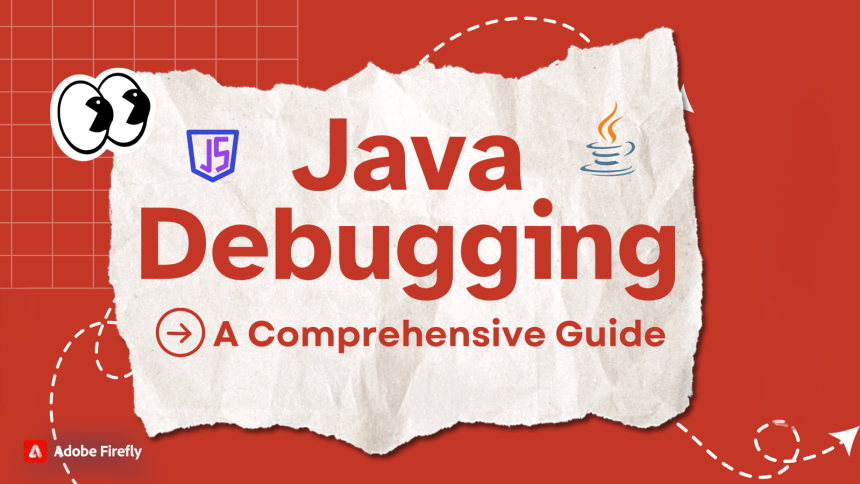Introduction

In the realm of Java development, encountering bugs is a common occurrence. Mastering the art of debugging is crucial for every Java developer seeking to create robust and error-free applications. Selecting the right tool from an array of Java debugging tools can significantly influence the efficiency of the debugging process, allowing developers to identify and resolve issues effectively.
Key Highlights
- Discover top-tier Java debugging tools for streamlined error resolution.
- Explore the capabilities of leading IDEs like Eclipse, IntelliJ IDEA, and NetBeans.
- Unleash the power of command-line debuggers for efficient troubleshooting.
- Master advanced techniques such as conditional breakpoints and remote debugging.
- Learn effective strategies to tackle complex errors in multithreaded applications.
Unveiling Top Tools and Techniques for Mastering Java Debugging

Java debugging stands as a cornerstone for developers aiming to deliver high-quality applications. Thankfully, a wealth of exceptional tools is at your disposal, each offering distinct features to simplify the process of identifying and rectifying errors in your Java code. This exploration will guide you through some of the most effective Java debugging tools and techniques, empowering you to debug like a pro and elevate your development workflow.
1. Eclipse: A Comprehensive Debugging Solution
Eclipse, a widely acclaimed open-source IDE renowned for Java development, comes equipped with robust debugging capabilities. Its advanced debugging features empower developers to thoroughly analyze their code during execution. The integrated Java debugger seamlessly blends with the development environment, offering a cohesive workflow for both coding and debugging tasks. Eclipse excels with its “Debug Perspective,” providing a consolidated view of essential debugging data, such as variables, breakpoints, threads, and call stacks, all neatly organized for easy access and analysis.
Within the Eclipse IDE, developers can effortlessly set breakpoints, execute code step by step, examine variables and their corresponding values, and conveniently suspend or resume threads as needed. These features contribute to a comprehensive and user-friendly debugging experience.
2. IntelliJ IDEA: Advanced Features for Java Debuggers
IntelliJ IDEA, crafted by JetBrains, stands as another powerful IDE widely favored by Java developers for its robust debugging features. Its intuitive design simplifies the process of identifying and resolving performance bottlenecks, leading to the creation of highly efficient and optimized Java applications. IntelliJ IDEA excels in its ability to provide a seamless debugging workflow, making it a top choice for developers seeking to expedite the process of finding and fixing code errors.
Among IntelliJ IDEA’s standout features is its exceptional inline debugging capability. This feature provides a clear and concise view of variable values directly within the code editor, eliminating the need to navigate through separate debugging windows. For developers who value a visually informative debugging experience, IntelliJ IDEA’s inline debugging is an invaluable asset.
3. NetBeans: User-Friendly Interface for Effective Debugging
NetBeans, an open-source IDE renowned for its user-friendly interface, offers a comprehensive suite of tools for streamlining Java development. Integrated seamlessly within NetBeans, the NetBeans debugger empowers developers to efficiently identify and rectify bugs within their Java applications, enhancing overall code quality and development speed. The intuitive design of the NetBeans debugger makes it particularly well-suited for both novice and experienced developers.
Navigating the debugger is a breeze, with straightforward options for setting breakpoints, stepping through code, and inspecting variables. Moreover, NetBeans extends its debugging capabilities to support the visual debugging of JavaFX applications. This feature allows developers to effectively target and resolve issues within the visual components of their applications.
4. JDeveloper: Integrated Development for Oracle Applications
JDeveloper, a comprehensive IDE developed by Oracle, provides robust support for the development of Java EE applications, particularly those deeply integrated with the Oracle ecosystem. A key strength of JDeveloper lies in its comprehensive integration with other Oracle technologies, making it an ideal choice for developers working within the Oracle ecosystem. This integration facilitates a streamlined development process, simplifying the development, debugging, and deployment of Java applications within Oracle environments.
With its suite of integrated tools, JDeveloper simplifies common debugging tasks such as setting breakpoints, stepping through code, and inspecting variables. Beyond these fundamentals, JDeveloper offers advanced debugging features specific to Java EE environments, allowing developers to effectively diagnose and resolve issues within enterprise-level Java applications.
5. Visual Studio Code: Versatile Debugging Across Environments
Visual Studio Code (VS Code), a popular cross-environment code editor, has gained significant traction among Java developers for its versatility and lightweight nature. Enhanced by a powerful extension ecosystem, VS Code transforms into a capable Java debugging environment, empowering developers to efficiently identify and resolve code issues across various platforms and project types. The debugger in VS Code is remarkably adaptable, seamlessly integrating with multiple programming languages and frameworks.
Through its intuitive interface, VS Code enables developers to effortlessly set breakpoints, execute code step by step, inspect variables, and leverage advanced features like conditional breakpoints. Furthermore, Visual Studio Code’s compatibility with remote debugging empowers developers to troubleshoot applications running in diverse environments, enhancing its flexibility and appeal.
6. JDB: The Classic Java Debugger

JDB (Java Debugger), a command-line debugger intrinsic to the Java SE Development Kit (JDK), delivers a robust toolset for in-depth debugging directly from the terminal. Its deep integration with the Java Virtual Machine (JVM) empowers developers to meticulously analyze program execution at a granular level. JDB is particularly valuable when conventional debuggers might fall short, especially in scenarios where resource constraints or the absence of a graphical environment necessitate a lightweight and efficient debugging tool.
While its command-line interface might demand familiarity with debugging commands, its capabilities for setting breakpoints, inspecting variables, and controlling threads offer unparalleled control over the debugging process.
7. Rookout: Real-Time Debugging Without Stopping the Application
Rookout emerges as a game-changer in the realm of Java debugging tools, particularly in the context of live production environments. Its capacity to capture debugging data without necessitating application restarts or code modifications makes it an indispensable asset for identifying and resolving issues in real-time. Rookout seamlessly integrates with a range of deployment environments, encompassing containers and serverless architectures, making it a versatile tool for modern application development.
One of its standout features is the ability to delve into live code execution, granting developers insights into the application’s behavior without interrupting its operation. Rookout also empowers developers to gather critical debugging information precisely when and where it’s needed, offering laser-focused troubleshooting without disrupting the end-user experience.
8. YourKit Java Profiler: Performance Tuning Made Easy
YourKit Java Profiler stands out as a powerful tool meticulously designed for optimizing the performance of Java applications by pinpointing and addressing performance bottlenecks. Its comprehensive suite of profiling features equips developers with deep insights into CPU performance, memory usage, and thread activities. By pinpointing performance bottlenecks, YourKit Java Profiler aids in identifying areas for code optimization, ultimately enhancing application responsiveness and efficiency.
The intuitive interface of the YourKit Java Profiler streamlines the process of profiling even complex applications. A notable feature of YourKit Java Profiler is its minimal overhead impact on the profiled application, making it well-suited for use in production environments, where maintaining application performance is paramount.
9. JUnit: Ensuring Code Reliability Through Testing
JUnit, a cornerstone in the realm of Java development, provides a comprehensive framework for conducting unit testing, a crucial practice for ensuring code reliability. By employing JUnit, developers can construct and execute automated tests that target specific units of code, verifying their functionality in isolation. This systematic approach to testing is invaluable for spotting and rectifying regressions early in the development cycle.
JUnit fosters a culture of test-driven development, which ultimately yields more robust and maintainable code. It allows for the creation of test cases, each designed to assess a specific aspect of the code’s behavior. Through the interpretation of test results, developers can readily identify discrepancies between expected and actual outcomes, thereby facilitating a targeted approach to bug fixing. This process not only verifies the correctness of individual code units but also contributes to a more robust and reliable codebase.
Advanced Techniques to Enhance Your Java Debugging Skills

Mastering fundamental Java debugging tools is only the first step; seasoned developers employ advanced techniques to elevate their debugging prowess and navigate complex debugging scenarios. These techniques empower developers to pinpoint and resolve issues with greater speed and accuracy, leading to more efficient debugging sessions.
Let’s explore some advanced Java debugging strategies tailored to streamline your debugging endeavors:
Streamlining Code with Conditional Breakpoints
Conditional breakpoints stand out as a potent tool in the realm of Java debugging. Unlike traditional breakpoints that halt execution at a specific line of code every time, conditional breakpoints empower developers to establish more targeted stopping points in their code. This selectivity proves particularly valuable when dealing with code segments that are repeatedly executed, such as loops or frequently called methods.
By introducing conditions to breakpoints, developers can ensure that the debugging process focuses solely on scenarios where the specified condition evaluates to true, such as a specific variable reaching a certain value or a particular exception being thrown.. This refined control over code execution streamlines the debugging process, particularly in intricate codebases.
Leveraging Remote Debugging for Distributed Applications
In the world of distributed applications, where components might be dispersed across multiple systems or environments, remote debugging emerges as an invaluable technique for Java developers. This technique enables developers to diagnose and resolve issues in applications that run outside their local development environment, such as applications deployed on remote servers or within complex cloud infrastructures.
Modern Java IDEs and debugging tools typically include built-in support for remote debugging. The process generally involves establishing a connection between the local development environment and the remote process hosting the Java application. Once this connection is established, developers can leverage familiar debugging features, such as setting breakpoints and inspecting variables, as if the application were running locally.
Utilizing Log Analysis for Efficient Error Tracking
Log analysis plays a crucial role in maintaining the health and stability of Java applications. By meticulously examining log files, developers can gain valuable insights into the runtime behavior of their applications and effectively track down errors. Log messages serve as valuable breadcrumbs, documenting an application’s actions, events, and errors.
Effective log analysis extends beyond merely reading log files. It involves employing tools and techniques to filter, search, and correlate information from vast amounts of log data. By carefully crafting log messages and adopting appropriate logging levels, developers can ensure that log files provide meaningful and actionable insights.
Adopting the Binary Search Method to Locate Bugs Faster
Inspired by the classic binary search algorithm, applying a similar approach during debugging sessions can dramatically accelerate the process of pinpointing the source of the problem within a Java application. Instead of linearly inspecting every line of code, the binary search method encourages developers to strategically divide the codebase into smaller, more manageable segments.
By systematically narrowing down the potential location of a bug, much like the binary search algorithm narrows down a search range, developers can eliminate large portions of code from suspicion.
Implementing Watch Points for Real-Time Variable Monitoring
Watchpoints present a powerful mechanism in Java debugging, enabling developers to monitor the values of variables or expressions in real-time as their code executes within the development environment. Unlike breakpoints that halt execution when a specific line of code is encountered, watchpoints allow the program to continue running until the variable or expression being monitored undergoes a change in value.
This proactive approach to variable monitoring is particularly insightful when tracking down elusive bugs where the value of a variable might change unexpectedly. Modern Java IDEs typically provide user-friendly interfaces for setting up and managing watchpoints, making it straightforward to incorporate this technique in your debugging workflow.
Troubleshooting Complex Errors in Java Applications

Within the realm of Java development, encountering complex errors is an inevitable part of the journey. These errors, often stemming from intricate interactions within the application or external dependencies, present unique challenges that extend beyond the scope of simple debugging techniques.
Let’s explore advanced strategies to effectively troubleshoot these complex errors in Java applications:
Analyzing Common Java Exceptions and How to Resolve Them
Java exceptions, represented by instances of the Throwable class, play an integral role in handling runtime errors and unexpected events that may arise during program execution. Understanding these common Java exceptions and adopting effective strategies to resolve them is essential for any Java developer.
Exceptions serve as mechanisms for signaling exceptional conditions encountered during program execution, such as attempting to access an array index that’s out of bounds or encountering an unexpected null value. Effective exception handling not only prevents abrupt program termination but also provides valuable clues for diagnosing the root cause of issues. By constructing robust exception handling mechanisms, you can ensure that your Java applications gracefully manage unexpected situations and provide informative error messages.
Debugging Multithreaded Applications: Strategies and Tools
Multithreaded programming, while a powerful technique for achieving concurrency and enhancing performance in Java applications, introduces complexities that can pose unique debugging challenges. The asynchronous nature of threads requires specialized debugging approaches and tools.
Understanding thread synchronization and potential race conditions is paramount when debugging multithreaded applications. Leverage specialized debugging tools provided by IDEs designed explicitly for handling the complexities inherent in multithreaded environments. Familiarize yourself with the threading model of the Java Virtual Machine (JVM) and techniques for managing thread interactions.
Addressing Memory Leaks with Heap Analysis Tools
In Java, memory is automatically managed by the Java Virtual Machine’s garbage collector. However, Java applications can still experience memory leaks if objects remain reachable, preventing their garbage collection. Memory leaks manifest as a gradual increase in memory consumption, ultimately leading to performance degradation and potential application crashes.
To mitigate memory leaks, Java developers employ a range of techniques. One important aspect involves understanding object references and ensuring proper object lifecycle management. By identifying objects that are no longer needed and releasing references to them, you can help the garbage collector reclaim unused memory. Regularly inspecting and analyzing the heap can reveal potential memory leaks and inefficient memory usage patterns, leading to more robust and resource-efficient applications.
Navigating through Stack Traces to Identify Error Sources
Stack traces provide invaluable debugging information, especially when exceptions occur, offering a structured representation of the call stack at the moment of the error. Each line in a stack trace represents a method call, with the most recent call at the top. By meticulously examining the order of method calls within a stack trace, developers can trace the execution flow backward, uncovering the sequence of events that led to the error.
This process of tracing back method calls is similar to retracing your steps after getting lost. By understanding the context provided by each method call in the stack trace, developers can identify the specific location in the code where the error originated.
Conclusion
In conclusion, mastering Java debugging requires a comprehensive understanding of the top tools and techniques available. From Eclipse to JUnit, each tool plays a crucial role in ensuring code reliability and efficient error tracking. By adopting advanced techniques like conditional breakpoints and log analysis, developers can streamline their debugging process and locate bugs faster. Troubleshooting complex errors in Java applications demands a strategic approach that includes analyzing common exceptions and addressing memory leaks. Enhancing your Java debugging skills is essential for developing robust and error-free applications. Stay ahead in your debugging journey by incorporating these tools and techniques effectively.
Frequently Asked Questions
What Makes a Java Debugging Tool Effective?
An effective Java debugging tool seamlessly integrates into your development environment, provides useful features such as breakpoints and step execution, and offers advanced features for identifying performance issues and memory leaks. Ease of use is pivotal for a smooth debugging experience.
How Can Conditional Breakpoints Speed Up Debugging?
Conditional breakpoints refine your debugging session, pausing program execution only when specific conditions within your Java code are met. This laser focus minimizes the need to repeatedly step through irrelevant code sections, enabling faster identification and fixing of bugs.
What Are the Best Practices for Debugging Multi-threaded Java Applications?
Debugging multithreaded applications in Java requires a keen understanding of thread synchronization and potential bugs arising from concurrent execution. Utilize specialized debugging tools, familiarize yourself with the Java Virtual Machine, and consider techniques for isolating and reproducing thread-related issues.



